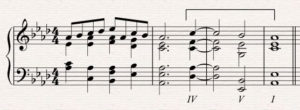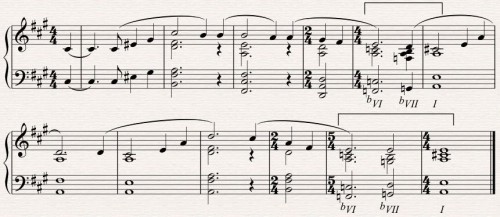So this is a post about William and Kate’s wedding you aren’t likely to see anywhere else.
If you saw William and Kate’s wedding (and who didn’t?) you heard some very nice music.
One piece you heard was John Rutter’s “This is the Day”, written especially for the service.
Fairly traditional, but with some nice little twists that made it just a bit different, just a bit more contemporary. Just what was it that gave it that slightly modern flavor?
First, let’s look at a standard final chord progression (click on the scores to listen):

The first bar doesn’t matter. The idea is that some key is already established, in this case, Ab Major. The bracketed part is what is important. Also, the chord symbols are simplified, I’m only indicating the root motion and the basic chord quality. So the above is pretty standard fair, found in a lot of hymns and songs.
A slightly stronger version sounds like this:

The other day, I was listening to British composer Malcolm Williamson. Here’s what he did in one of his anthems:

Really nice. He’s dipping into Ab minor for a moment here. The V, Eb Major, is shared; it exists in both Ab harmonic minor and Ab Major and sort of bridges between the two.
Notice the root motion: a Major 2nd up ( iv -> V), followed by the traditional 5th down ( V -> I). That’s one of the ways you can tell it’s not my work. I tend to reverse those two motions, avoiding the traditional motion at the end. Like this:

So the 5th downward comes first ( iv -> bVII ), then the Major 2nd up ( bVII -> I ). The dip into Ab minor is firmly established as natural minor by the bVII, then the reversal back to major at the end (no ‘bridge’ needed!).
So now we’re ready to talk about John Rutter’s “This is the Day”. Of course, I haven’t seen the score, but I think I heard the essential harmonies correctly. At the end, a lesser composer would have written:

Again, the cadences in question are in brackets. Above, we have all 5th-down root motion: ii – V – I. Perfectly fine, but traditional enough to border on the trite. Below is what Rutter actually did:

All Major-second-up root motion. Makes a big difference doesn’t it? This is one of my favorite cadences. I use it all the time, and it works in many contexts. Traditional, yet modern at the same time.
So now you know.





